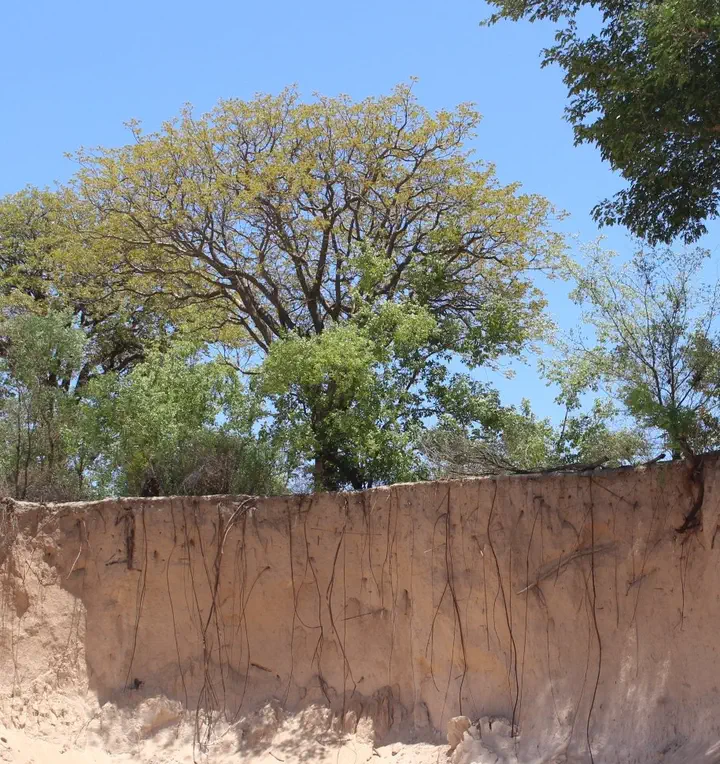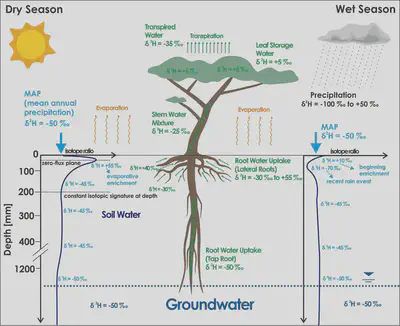A brief on deep water uptake in water-limited environments
A conceptual explanation
 The proof: deep roots exist
The proof: deep roots existHey folks, I wrote down this little methodological post on identifying deep water uptake using isotope techniques, hope you like it!
The methodological aspect of identifying deep water uptake through plants’ roots requires further attention. We focus here on methods based on water isotopes but refer to (Maeght, 2013) and (Pierret, 2016) for an overview of methods for studying deep roots. Natural abundances of water isotopes for quantifying deep soil/groundwater uptake. The fact that water isotopes are an ideal tracer for water water (and not a substance with different hydrochemical properties), their capability of tracing fluxes from the soil through the plant and into the atmosphere, the minimum-invasive character and ease of handling due to recent advances in analytical techniques make water isotopes a highly versatile tool for studying the hydrological cycle and investigate soil plant atmosphere interactions.

Under well-defined preconditions, techniques based on stable water isotopes can be used to identify the contribution of each water source (e.g. soil and groundwater) to a mixture (the water within the stem of plant). These prerequisites are that the isotopic composition of all potential sources is captured and the isotopic compositions of these sources differ from each other (i.e. isotopic ratios from groundwater are different from soil water isotopes and the isotopic composition of the soil water profile is not constant). Under these conditions, the contribution of each water source to the mixture of water in the stem can be determined using isotopic mixing models (for a recent review on mixing models, we refer to (Rothfuss, 2016).
Many studies applying these principles have been carried out in the last decades (Cook, 2006; Dawson, 1991; Dawson, 1996; Grossiord, 2016; Rings,2013; Zhao, 2016) . {Chimner, 2004) used stable isotopes to examine the water sources of native shrubs in the desert environment of San Luis Valley, Colorado (USA). The authors found that different desert shrubs are able to tap groundwater deeper than 2 m depth, even though their isotopic analysis is based on an incomplete soil profile. In addition, their deep soil and groundwater isotopic compositions are almost identical, which makes an interpretation only based on water isotopes non-conclusive. The latter is a crucial point limiting the applicability of natural abundances and/or mixing models for inferring deep water uptake of water-limited sites: the before mentioned prerequisites are often not fulfilled because the isotopic signatures of the potential water sources for plants do not differ substantially. We thoroughly elaborate on the underlying theories in this section.
The crux : similar isotopic signatures at depth
In thick unsaturated zones of many water-limited environments the characteristic profile of soil water isotopes at depth approaches a constant value (Allison, 1984; Cook 1994; Clark; 1997). In the Figure above , the soil-vegetation-atmosphere continuum of a typical semi-arid environment - from a stable isotope perspective - is illustrated for the wet and dry season, respectively.
In temperate, continental regions, this constant value at depth often resembles the isotopic signature of weighted mean annual precipitation (Dawson, 1991). In drier environments, however, it more likely reflects the weighted mean of heavier rain events that infiltrate deeper. Different explanations were also given earlier, but rectified later; see (Allison, 1984; Allison, 1988). In addition, deep soil water and groundwater often have a similar isotopic composition, if groundwater is not of fossil origin (Dawson, 1991). Hence, three potential water sources with a near-similar isotopic signature exist and would lead to ambiguous results when applying any mixing model. As a consequence, it is not possible (with stable water isotopes) to evaluate uptake depths from soil layers deeper than the critical depth, if the soil water isotope profile becomes constant. In fact, only within the shallow soil (we define shallow soil as soil with depth less than 1m) - which is affected by direct evaporation and diffusion/mixing - the isotopic signatures (enriched in heavy isotopes) can be clearly distinguished from precipitation input, deep soil water and groundwater.
Lots of research to be done here - how can we identify deep water uptake in such environments more precise? Looking forward to discuss and work on this topic!
References
Maeght, J.-L., Rewald, B., & Pierret, A. (2013). How to study deep roots-and why it matters. Frontiers in Plant Science, 4, 299. https://doi.org/10.3389/fpls.2013.00299
Rothfuss, Y., & Javaux, M. (2016). Isotopic approaches to quantifying root water uptake and redistribution: a review and comparison of methods. Biogeosciences Discussions, 1–47. https://doi.org/10.5194/bg-2016-410
Cook, P. G., & O’Grady, A. P. (2006). Determining soil and ground water use of vegetation from heat pulse, water potential and stable isotope data. Oecologia, 148(1), 97–107. https://doi.org/10.1007/s00442-005-0353-4
Dawson, T. E., & Ehleringer, J. R. (1991). Streamside trees that do not use stream water. Nature, 350(6316), 335–337. https://doi.org/10.1038/350335a0
Dawson, T. E., & Pate, J. S. (1996). Seasonal water uptake and movement in root systems of Australian phraeatophytic plants of dimorphic root morphology: a stable isotope investigation. Oecologia, 107(1), 13–20. https://doi.org/10.1007/BF00582230
Grossiord, C., Sevanto, S., Dawson, T. E., Adams, H. D., Collins, A. D., Dickman, L. T., Newman, B. D., Stockton, E. A., & McDowell, N. G. (2016). Warming combined with more extreme precipitation regimes modifies the water sources used by trees. New Phytologist. https://doi.org/10.1111/nph.14192
Rings, J., Kamai, T., Kandelous, M., Hartsough, P., Simunek, J., Vrugt, J. A., & Hopmans, J. W. (2013). Bayesian Inference of Tree Water Relations Using a Soil-Tree-Atmosphere Continuum Model. Procedia Environmental Sciences, 19, 26–36. https://doi.org/10.1016/j.proenv.2013.06.004
Zhao, L., Wang, L., Cernusak, L. A., Liu, X., Xiao, H., Zhou, M., & Zhang, S. (2016). Significant Difference in Hydrogen Isotope Composition Between Xylem and Tissue Water in Populus Euphratica. Plant, Cell & Environment, 39(8), 1848–1857. https://doi.org/10.1111/pce.12753
Chimner, R. A., & Cooper, D. J. (2004). Using stable oxygen isotopes to quantify the water source used for transpiration by native shrubs in the San Luis Valley, Colorado U.S.A. Plant and Soil, 260(1/2), 225–236. https://doi.org/10.1023/B:PLSO.0000030190.70085.e9
Allison, G. B., Barnes, C. J., Hughes, M. W., & Leaney, F. W. (1984). Effect of climate and vegetation on oxygen-18 and deuterium profiles in soils. International Symposium on Isotope Hydrology in Water Resources Development, 105–122. http://www.researchgate.net/publication/201995709_Effect_of_climate_and_vegetation_on_oxygen-18_and_deuterium_profiles_in_soils
Cook, P. G., Jolly, I. D., Leaney, F. W., Walker, G. R., Allan, G. L., Fifield, L. K., & Allison, G. B. (1994). Unsaturated zone tritium and chlorine 36 profiles from southern Australia: Their use as tracers of soil water movement. Water Resources Research, 30(6), 1709–1719. https://doi.org/10.1029/94WR00161
Clark, I. D., & Fritz, P. (1997). Environmental Isotopes in Hydrogeology (p. 341). CRC Press. https://www.researchgate.net/publication/201169434_Environmental_Isotopes_in_Hydrogeology_Lewis
Allison, G. B. (1988). A Review of Some of the Physical, Chemical and Isotopic Techniques Available for Estimating Groundwater Recharge. In I. Simmers (Ed.), Estimation of Natural Groundwater Recharge (pp. 49–72). Springer Netherlands. http://dx.doi.org/10.1007/978-94-015-7780-9_4